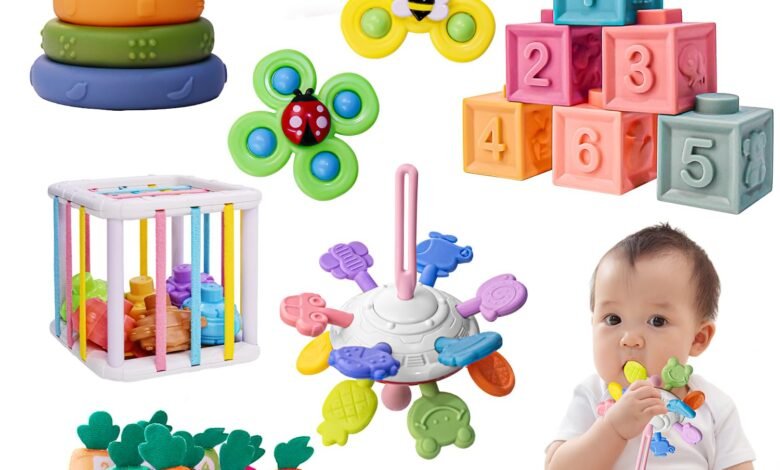
The Ultimate Guide to Baby Toys: What Every Parent Should Know
When it comes to baby toys, it’s more than just keeping your little one entertained. Toys are essential tools for developmehttps://www.google.com/search?sca_esv=54dec9b54f70a6a6&rlz=1CAUHAM_enPK1171&sxsrf=AE3TifOkQTrvp2ylD98D2PdUMVjoXoia7w:1752738731595&q=baby+toys&udm=2&fbs=AIIjpHxU7SXXniUZfeShr2fp4giZ1Y6MJ25_tmWITc7uy4KIeoJTKjrFjVxydQWqI2NcOha3O1YqG67F0QIhAOFN_ob1xGdzU5Cnyn-oUzTul2B5TXRzAeIy3FI7wzggwHPeZE5cVxJF3TSy6VJy__A91WVw8jso2MVzslHtne5IBzFZ7wiBgKvuGJadfgZ9to9wUGx5Slqn&sa=X&sqi=2&ved=2ahUKEwiCjOzLtMOOAxVhS_EDHakYGKcQtKgLKAF6BAgTEAE&biw=1366&bih=681&dpr=1#sv=CAMSggUa3QQKigIKuQEStgEKd0FMa3RfdkZCc0J4dEZKRFZkci10OVJEUjJxX1piNlJtMFFnWkg1NlRhWUVJSEZlald2dUl1bFBVX0szSS05T1IwdnRvdTVUeHh4SlFIQzRHZWdiZ3pEMkd2S0N3dDI3SFRFaEs0cWU4WkFNUFM0ellhQTVOMFRjEhdzcXQ0YUxlaEdkNmJrZFVQaFB1ejZRaxoiQUZNQUdHcUxhWS1nSTVOTWlfSnQyNFRNOUhEOTlNS0prdxIDODQ5GgEzIg4KAXESCWJhYnkgdG95cyIHCgN0YnMSACIrCgRlcWxkEiNDZ0lJQUJBQU9nUUlBQkFCU0FGVmtSMV9QMkFCYlF1UkdUOBK7AgrPARLMAQqMAUFMa3RfdkZGRHpxcVp6c2xvYUFvWVFXXzJ1aGFibUpWRWEyRVpFeXlqQ1YtVXB6MUlkYTdvZGx6a2EtZW9OV1RCRUlqcnBOd0NIUjY3RFZnNWkzcDljTlFaR2dabzhoUXAxTGxjZzNqeE5VeDRYcldzcTNNQmFhSjRDSHd5WlE5Z0RFM0NvVlZjOXhLEhdzcXQ0YUxlaEdkNmJrZFVQaFB1ejZRaxoiQUZNQUdHckQwdVB2dWdQb2pTcHd0NFNRRjZoX2tXdGQzZxIENDY5OBoBMyIYCgZpbWdkaWkSDmFGYmJRV3A1eDBRZktNIhcKBWRvY2lkEg5JSi1YdlBzZXBNM3A4TSIrCgRlcWxkEiNDZ0lJQUJBQU9nUUlBQkFCU0FGVmtSMV9QMkFCYlF1UkdUOCoQZS1hRmJiUVdwNXgwUWZLTSAEKhwKBm1vc2FpYxIQZS1hRmJiUVdwNXgwUWZLTRgAMAEYByCumfDhCDACQAInt, learning, and even emotional growth. But with so many options out there, how do you pick the right ones? This guide is designed to walk you through everything you need to know about baby toys—from safety and developmental benefits to types and buying tips. Let’s dive in!
Why Baby Toys Are More Than Just Playthings
They Support Early Brain Development
A baby’s brain develops at an astonishing rate in the first few years of life. Toys, especially those that stimulate the senses—like rattles, textured balls, and colorful stacking rings—help build neural connections. When babies explore their toys through touch, sight, and sound, they’re not just playing—they’re learning about the world.
Take a soft musical toy, for example. While it seems simple, it encourages a baby to listen, react, and sometimes even move. This supports both auditory processing and motor coordination. Toys like shape sorters or stacking cups also teach basic problem-solving, cause and effect, and spatial awareness.
They Help Babies Build Motor Skills
Grasping, shaking, banging, chewing—these are all important movements for developing gross and fine motor skills. When a baby grips a rattle, they’re strengthening the small muscles in their hands and fingers. As they grow older and start interacting with blocks or push-and-pull toys, they learn coordination and balance.
Toys like baby gyms and activity centers are excellent for encouraging movement. Babies are motivated to reach, roll, and eventually crawl toward their favorite toy. These kinds of toys transform floor time into skill-building sessions.
They Encourage Emotional and Social Development
Soft dolls, plush animals, and interactive toys can help babies build emotional connections and learn empathy. Even before they speak, babies often show preference and affection toward certain toys. These emotional bonds help develop a sense of comfort and security.
As babies start interacting more with caregivers and other children, toys also become tools for social learning. They begin to understand concepts like sharing, turn-taking, and cooperative play. A simple game of peek-a-boo or rolling a ball back and forth lays the foundation for more complex social skills later on.
The Best Toys for Every Stage of Baby’s Development
0–3 Months: Sensory Exploration
In the newborn stage, babies are just beginning to understand their surroundings. Their vision is still developing, so high-contrast toys in black, white, and red are ideal. Soft rattles, crinkle toys, and musical mobiles stimulate both hearing and sight.
During tummy time, a soft mat with mirrors and dangling toys can make all the difference. Not only does it keep them engaged, but it also strengthens neck and shoulder muscles—crucial for future milestones like crawling.
3–6 Months: Reaching and Grabbing
Around this time, babies become more interested in reaching for and grabbing objects. Toys that are easy to hold and safe to chew on (because teething begins around here too) are a must. Think teething rings, fabric books, and textured rattles.
You’ll also start noticing that your baby has preferences—they may reach for one toy more than another or react differently to sounds and textures. This is the perfect time to introduce toys that crinkle, squeak, or light up when touched.
6–12 Months: Mobility and Curiosity
By six months, many babies are sitting up and exploring their environment. They’re ready for more interactive toys. Stacking rings, nesting cups, and simple shape sorters encourage problem-solving and hand-eye coordination.
Push toys, crawl-along vehicles, and musical instruments like baby drums or xylophones help them develop gross motor skills. This is also when babies begin to mimic adults—so don’t be surprised if a baby cellphone or toy remote becomes their favorite thing.
What to Look for in a Baby Toy: Safety First
Material Matters
Always check the materials used in baby toys. Look for BPA-free plastics, organic cotton, and non-toxic paints. Babies explore with their mouths, so anything they play with is likely to get chewed on at some point.
Wooden toys can be a great choice, especially those finished with natural oils. They’re durable, safe, and environmentally friendly. Just make sure they don’t have small parts that could become choking hazards.
Size and Shape
Avoid toys with small, detachable pieces. A good rule of thumb: if it can fit through a toilet paper roll, it’s too small for a baby. Also, avoid toys with sharp edges, strings, or cords that could pose strangulation risks.
Toys should be large enough to prevent swallowing but light enough for little hands to hold. Rounded edges and smooth finishes are a must.
Certifications and Labels
Look for safety certifications like ASTM, CE, or JPMA labels. These indicate that the toy has passed rigorous safety standards. And always read age recommendations—some toys may look cute and harmless but aren’t suitable for young babies.
Educational Toys That Grow With Your Baby
Montessori-Inspired Toys



